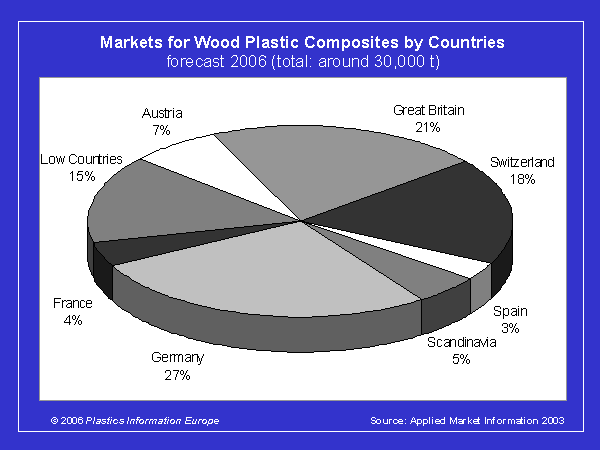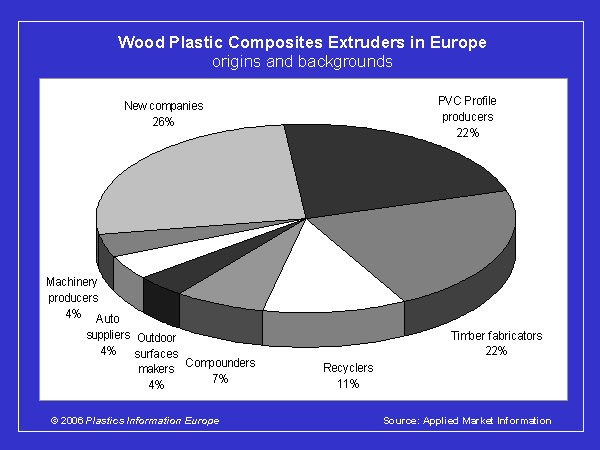WOOD PLASTIC COMPOSITES
Growing importance worldwide / North America by far the largest market / Niche application in Europe / Plenty of potential for nature fibre reinforced material / Symposium in Germany
Global interest in wood plastic composites (WPCs) is increasing constantly, and the growth rates for this young class of materials are extremely high, compared with conventional materials. In Europe, however, sales volumes are still very small. Backers of WPCs therefore see tremendous opportunities for these materials, both as a weather-resistant alternative to wood and as an inexpensive substitute for other plastics.
WPC products were first produced and sold in large quantities in North America, and this is still the largest market by far. In a study of the global market, Germany´s nova-Institut (Hürth; www.nova-institut.de) estimates North American production in 2005 at around 700,000 t, compared with 600,000 t in 2003 and just 135,000 t in 2000. The composite of wood, plastic and additives can be processed like a thermoplastic and is used primarily in North America for outdoor decking. Because they have good weather stability and are pleasant to the touch, WPCs can successfully compete against conventional timber products. Market analysts believe annual consumption could soon breach the 1m t barrier in the US and Canada.
WPC products were first produced and sold in large quantities in North America, and this is still the largest market by far. In a study of the global market, Germany´s nova-Institut (Hürth; www.nova-institut.de) estimates North American production in 2005 at around 700,000 t, compared with 600,000 t in 2003 and just 135,000 t in 2000. The composite of wood, plastic and additives can be processed like a thermoplastic and is used primarily in North America for outdoor decking. Because they have good weather stability and are pleasant to the touch, WPCs can successfully compete against conventional timber products. Market analysts believe annual consumption could soon breach the 1m t barrier in the US and Canada.
 | |
Europe: WPC slowly gaining popularity
While reasonably detailed figures are available for WPCs in North America, data for European and Asian markets is scarce. European market volume was estimated to be around 30,000 t in 2003, although the figure is likely to have risen significantly since then. In any case, Germany – where WPC output doubled to around 10,000 t from 2004 to 2005 – accounts for the lion´s share. There is no doubt that the European market is growing in importance, both from a production and consumption standpoint.
Although decking is nowhere near as popular in Europe as in the US, and outdoor flooring is unlikely to become a major hit in Europe in the near future, there are still a number of other large potential applications. In the indoor segment and automotive construction in particular, a great deal of research is being carried out, and marketing activities are also being stepped up. Traditional timber producers, for example, are attempting to tap new markets with WPC products, and considerable investment and capacity expansions can be expected here in the near future.
International WPC symposium in Germany
The expected dynamic development in Europe was also corroborated by many of the around 350 specialists attending the "6th Global Wood and Natural Fibre Composites Symposium" organised by the Chair of Plastics and Recycling Technology at the University of Kassel (www.kutech-kassel.de) in Germany this spring. At this important international conference, interest focused not only on WPCs but also on a wide variety of natural fibre-reinforced plastics (NRPs).
New applications include chain links made of polyamide and wood fibre that can even serve as a substitute for steel, and metallised WPCs. Interesting furniture creations such as an Ikea chair made of WPC material showed that, particularly in the field of wood-filled plastics, a new development phase has been born, the organisers said.
Natural fibres dominate the Asian market
The Asian market still has plenty of potential for wood-plastic composites, reports suggest. More than in other worldwide region, Asian producers use natural filling and reinforcing materials such as rice, kenaf (fibre plant of the hibiscus family), palm fibres and hemp. Here, the composites are also used in decking, panels, doors and windows, as well as in furniture. The Asian market is so diversified and heterogeneous that accurate data on its size is almost impossible to find. Nova-Institute puts production for 2003 in Japan at 30,000 t.
Large potential for new applications
The many natural fibre-reinforced plastic and wood-plastic composite materials are indeed varied, and so, too, are their possible applications. The better the properties, the higher the cost, say the experts. Highly filled WPC extrusion parts, for example, are suitable only for components with a constant cross section and can resist only moderate mechanical loads. In its online presentation, "natural fibre reinforced plastics", nova lists such possible applications as decking, rods, table legs and window frames. It says WPC injection moulding with wood fibre reinforcement is also possible in small series, with the applications virtually identical.
Natural fibre-reinforced polypropylene (NRPP) is said to offer high strength and can even reach the values of GRPP-30 (the best variants). According to the institute, shrinkage and temperature resistance could match that of PC/ABS, while at the same time offering higher strength. Consequently, a broad spectrum of applications exists.
Wherever appearance of the unlaminated composite is not a factor or if the part is not directly visible, it can be used in the same applications as standard plastics. For electronic housings, kitchen appliances, plastic baskets, handles and office materials, for example, it offers high substitution potential as long as a high-performance compound is not needed, experts say.
 | |
26.06.2006 Plasteurope.com [205456]
Published on 26.06.2006
